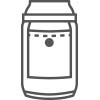Released in 2017, the Old Growth print quickly became one of our best-selling prints ever. It’s easy to see why: a photo-real shot of a gorgeous old growth grove, captured by photographer Jeremy Koreski from well above the canopy at the height of spring offered a new perspective on one of Rumpl fans’ favorite outdoor playgrounds. We teamed up with Jeremy again to introduce a brand new print "Gold Growth" just in time for fall, as well as bring back "Old Growth" and "Cold Growth" to our Growth Series
The Growth Series doesn’t just look good, it does good, too. In addition to teaming up with Jeremy Koreski for this series, we're donating $5,000 to the Raincoast Conservation Foundation - a team of scientists and conservationists working to protect the land, water, and wildlife of coastal British Columbia. We caught up with Chris Genovali, the Executive Director of the Raincoast Conservation Foundation to learn more about the work they're doing.
Photo Credit: Alex Harris / Raincoast Conservation Foundation
Photo Credit: Alex Harris / Raincoast Conservation Foundation
Can you tell us a bit more about the Raincoast Conservation Foundation?
Raincoast is a team of conservationists and scientists empowered by our research to protect the lands, waters and wildlife of coastal British Columbia, and the cross-border Salish Sea region in the Pacific Northwest. We use rigorous, peer-reviewed science and community engagement to further our conservation objectives. We call this approach ‘informed advocacy’. As a charitable, non-profit conservation science organization that operates a university research lab, research field station and a research/sailing vessel, we are unique in the ENGO world.
Can you speak to the importance of peer-reviewed scientific research in the work that you do?
Raincoast staff scientists conduct applied, process-oriented, and hypothesis-driven research that has immediate and relevant utility for the conservation debate and our collective body of scientific knowledge. Our scientific research forms the basis of our conservation efforts. Additionally, we have an applied conservation science lab at the University of Victoria; the Raincoast Lab has been producing cutting-edge peer-reviewed research on large carnivores and wild salmon for over a decade.
Photo Credit: Alex Harris / Raincoast Conservation Foundation
What are some major action items for your organization in the coming years?
-
Our Healthy Waters program is a new and responsive community-oriented pollution monitoring initiative for salmon and whale habitat in British Columbia, with the goal of demystifying water pollution and developing community-oriented water pollution monitoring that ensures clean water in the habitats of salmon, whales, and communities.
-
Our Wild Salmon program is focused on ensuring that British Columbia’s 450 plus Conservation Units of wild salmon persist over their historic range to meet the needs of wildlife and ecosystems, with an emphasis on the needs of endangered Southern Resident killer whales.
-
Our Lower Fraser River Salmon Conservation program has the goal of seeing healthy populations of wild salmon returning to the Fraser River (one of the world’s great rivers) by implementing habitat restoration projects and ecological governance.
-
Our Gulf Islands Forest project seeks to identify measures that will protect British Columbia’s threatened Coastal Douglas Fir (CDF) ecosystem and promote resilience at a time of increasing development on and around the Southern Gulf Islands, which contain over 25% of CDF habitats. Our intention is to increase the amount of protected area within the CDF.
Photo Credit: Alex Harris / Raincoast Conservation Foundation
Photo Credit: Alex Harris / Raincoast Conservation Foundation
What are the biggest challenges or barriers your organization faces?
Securing the financial resources to continue this vital work is a constant challenge, so we are grateful for the support of companies like Rumpl.
How can people get involved with the work that you’re doing?
The best way for people to get informed, support or work, and take action on any of the aforementioned issues is to visit our website. People can also check out our social media channels (Twitter, Instagram, and Facebook) for breaking news and updates.
Photo Credit: Alex Harris / Raincoast Conservation Foundation





